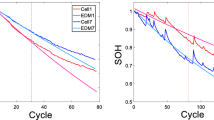Abstract
One of the important aspects in achieving better performance for transient stability assessment (TSA) of power systems employing computational intelligence (CI) techniques is by incorporating feature reduction techniques. For small power system the number of features may be small but when larger systems are considered the number of features increased as the size of the systems increases. Apart from employing faster CI techniques to achieve faster and accurate TSA of power system, feature reduction techniques are needed in reducing the input features while preserving the needed information so as to make faster training of the CI technique. This paper presents feature reductions techniques used, namely correlation analysis and principle component analysis, in reducing number of input features presented to two CI techniques for TSA, namely probabilistic neural network (PNN) and least squares support vector machines (LS-SVM). The proposed feature reduction techniques are implemented and tested on the IEEE 39-bus test system and 87-bus Malaysia’s power system. Numerical results are presented to demonstrate the performance of the feature reduction techniques and its effects on the accuracies and time taken for training the two CI techniques.
Similar content being viewed by others
References
Abdul Wahab NI, Mohamed A, Hussain A (2007) Transient stability assessment of a power system using PNN and LS-SVM methods. J Appl Sci 7(21): 3208–3216
Andersson C (2005) Power system security assessment: application of learning algorithm. PhD thesis. Lund University, Sweden
Burrascano P (1991) Learning vector quantization for the probabilistic neural network. IEEE Trans Neural Netw 2(4): 458–461
Chen S, Cowan CFN, Grant PM (1991) Orthogonal least squares learning algorithm for radial basis function networks. IEEE Trans Neural Netw 2(2): 302–309
Cios KJ, Swiniarski RW, Pedrycz W, Kurgan LA (2007) Data mining: a knowledge discovery approach. Springer, New York
Demuth H, Beale M, Hagan M (2006) Neural network toolbox v5 for use with Matlab. The Math works Inc, Natick
Gu XP, Tso SK, Zhang Q (2000) Combination of rough set theory and artificial neural networks for transient stability assessment. Int Conf Power Syst Technol 1: 19–24
Harinder S, Jeyasurya B (2006) A feed-forward artificial neural network with enhanced feature selection for power system transient stability assessment. Electr Power Syst Res 76(12): 1047–1054
Hotelling H (1933) Analysis of a Complex of statistical variables into principal components. J Educ Psychol 24:417–441; 498–520
Huang D-S, Du J-X (2008) A constructive hybrid structure optimization methodology for radial basis probabilistic neural networks. IEEE Trans Neural Netw 19(12): 2099–2115
Jensen CA, El-Sharkawi M, Marks RJ (2001) Power system security assessment using neural networks: feature selection using Fisher discrimination. IEEE Trans Power Syst 16(4): 757–763
Kim M, Joo S-K (2006) Feature reduction techniques for power system security assessment. In: Jiao L et al (eds) Lecture notes in computer science–advances in natural computation. Springer, Berlin, pp 525–534
Lin G, Lv W, Tongwen W (2007) Feature selection and rule extraction for the estimation of power system transient stability. Int Power Eng Conf 12: 389–394
Mitra P, Murthy CA, Pal SK (2002) Unsupervised feature selection using feature similarity. IEEE Trans Pattern Anal Mach Intell 24(3): 301–312
Moulin LS, da Silva APA, El-Sharkawi MA, Marks RJ (2002) Support vector and multilayer perceptron neural networks applied to power systems transient stability analysis with input dimensionality reduction. IEEE PES Summer Meet 3: 1308–1313
Pearson K (1901) On lines and planes of closest fit to systems of points in space. Philos Mag 2(11): 559–572
Sawhney H, Jeyasurya B (2006) A feed-forward artificial neural network with enhanced feature selection for power system transient stability assessment. Electr Power Syst Res 76(12): 1047–1054
Sedano J, Curiel L, Corchado E, de la Cal E, Villar JR (2010) A soft computing method for detecting lifetime building thermal insulation failures. J Integr Comput-Aided Eng 17(2): 103–115
Suykens JAK, Vandewalle J (1999) Least squares support vector machines classifier. Neural Process Lett 9(3): 293–300
Suykens JAK, Van Gestel T, De Brabanter J, De Moor B, Vandewalle J (2002) Least squares support vector machines. World Scientific, Singapore
Specht F (1992) Enhancements to probabilistic neural networks. Int Joint Conf Neural Netw 1: 525–532
Specht DF (1988) Probabilistic neural networks for classification, mapping, or associative memory. IEEE Int Conf Neural Netw 1: 525–532
Tso SK, Gu XP (2004) Feature selection by separability assessment of input spaces for transient stability classification based on neural networks. Electr Power Energy Syst 26(3): 153–162
Valyon J, Horvath G (2004) A sparse least squares support vector machine classifier. IEEE Int Joint Conf Neural Netw 1: 543–548
Yusof SB, Rogers GJ, Alden RTH (1993) Slow coherency based network partitioning including load buses. IEEE Trans Power Syst 8(3): 1375–1382
Zhang Q, Tso SK, Gu XP, Han ZX (2000) Extraction of representative attributes as neural-network inputs for power-system transient stability assessment. Int Conf Adv Power Syst Control Oper Manag 2: 390–394
Author information
Authors and Affiliations
Corresponding author
Rights and permissions
About this article
Cite this article
Wahab, N.I.A., Mohamed, A. & Hussain, A. Feature Selection and Extraction Methods for Power Systems Transient Stability Assessment Employing Computational Intelligence Techniques. Neural Process Lett 35, 81–102 (2012). https://doi.org/10.1007/s11063-011-9205-x
Published:
Issue Date:
DOI: https://doi.org/10.1007/s11063-011-9205-x




